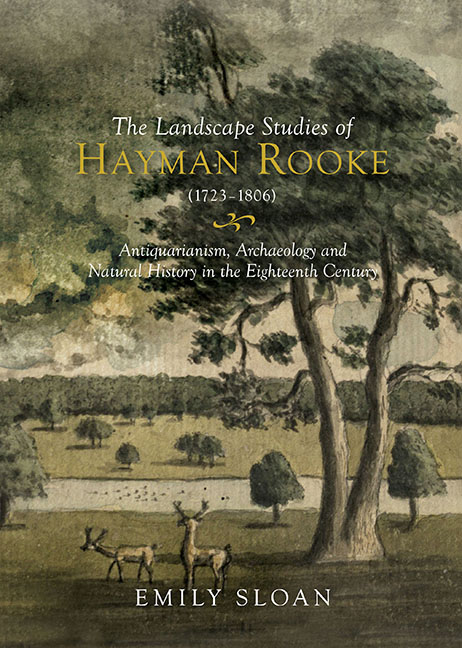 The Landscape Studies of Hayman Rooke (1723–1806)
The Landscape Studies of Hayman Rooke (1723–1806) Published online by Cambridge University Press: 31 August 2019
It was not unusual for an antiquary to maintain an interest in natural phenomena. Natural history fell within the remit of eighteenthcentury observational science, embracing the study of flora and fauna, environmental characteristics such as rocks and soil, and the air. Rooke's studies encompassed such diverse subjects as fungi, geology and volcanoes, as well as trees and meteorology. Such apparently diverse topics came together in eighteenth-century regional histories, and can be clearly seen in Plot's Natural History of Oxfordshire, published in 1705, for example. Plot stated that he would ‘consider, first, Natural Things, such as she produces in her ordinary Course; as Animals, Plants, and the universal Furniture of the World. Secondly, her extravagancies and defects, as in Monsters. And then lastly, as she is restrained, forced, fashioned, or determined, by Artificial Operations. All which, without Absurdity, may fall under the general Notation of a Natural History.’ Unusual atmospheric phenomena were described under the ‘Arts’ section of the book, ‘Since … the Celestial Bodies are so remote, that little can be known of them without the help of Art’, but storms and lightning strikes were included in the first chapter, ‘Of the ‘Heavens and Air’. Subsequent chapters addressed different rock types and fossils, both of which were considered by Rooke, although there is less extant material on Rooke's interests in these areas. Prodigiously large oaks found mention in Plot's work, as in Rooke's pamphlets, and the final chapter of Plot's work addressed antiquities, ‘such as ancient Money, Ways, Barrows, Pavements, Urns, ancient Monuments of Stone, Fortifications, & c. whether of the ancient Britans, Romans, Saxons, Danes, Normans’.
Rooke's own interest in antiquarian, natural history and meteorological investigation was therefore not incongruous within the climate of the time, although Rooke followed his own path without slavishly copying the route of published examples. Rooke's accounts diverged from the outline of Plot's natural history in the absence of material regarding ‘Birds, Insects, Fishes, Reptils, and Four-footed Beasts’ or on ‘Men and Women’. Whilst there is a sheet in Rooke's sketches of a study of an unidentified caterpillar, it may be that this kind of study became too specialised to warrant inclusion in a county history.
To save this book to your Kindle, first ensure [email protected] is added to your Approved Personal Document E-mail List under your Personal Document Settings on the Manage Your Content and Devices page of your Amazon account. Then enter the ‘name’ part of your Kindle email address below. Find out more about saving to your Kindle.
Note you can select to save to either the @free.kindle.com or @kindle.com variations. ‘@free.kindle.com’ emails are free but can only be saved to your device when it is connected to wi-fi. ‘@kindle.com’ emails can be delivered even when you are not connected to wi-fi, but note that service fees apply.
Find out more about the Kindle Personal Document Service.
To save content items to your account, please confirm that you agree to abide by our usage policies. If this is the first time you use this feature, you will be asked to authorise Cambridge Core to connect with your account. Find out more about saving content to Dropbox.
To save content items to your account, please confirm that you agree to abide by our usage policies. If this is the first time you use this feature, you will be asked to authorise Cambridge Core to connect with your account. Find out more about saving content to Google Drive.